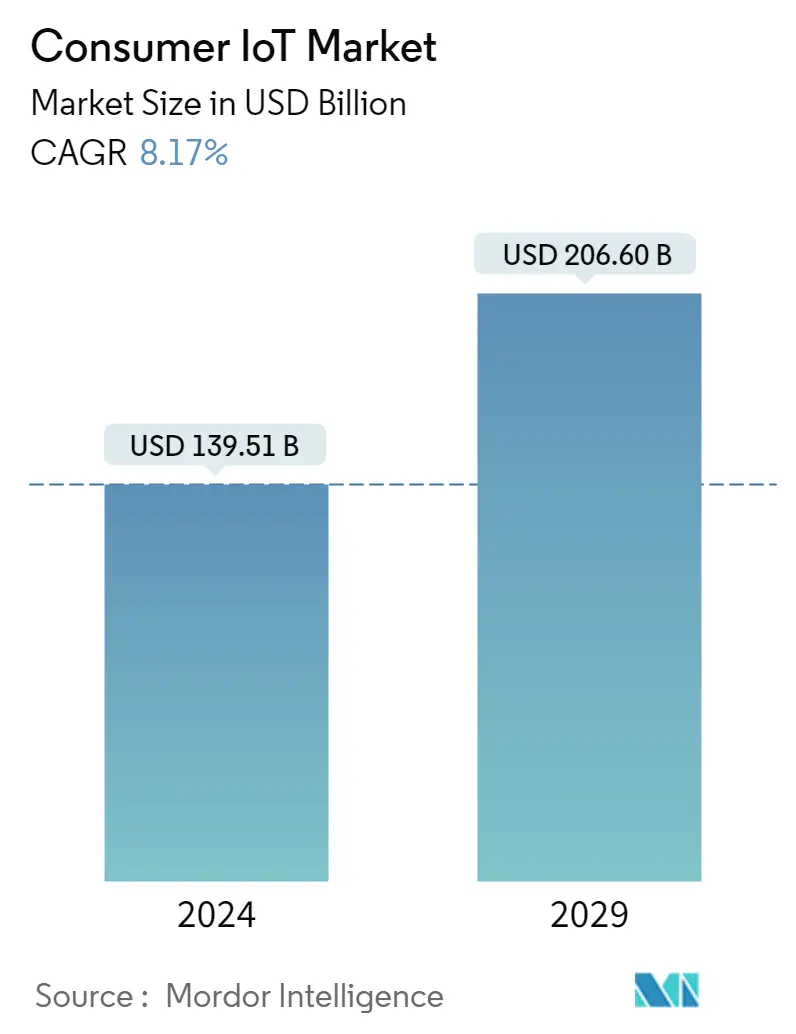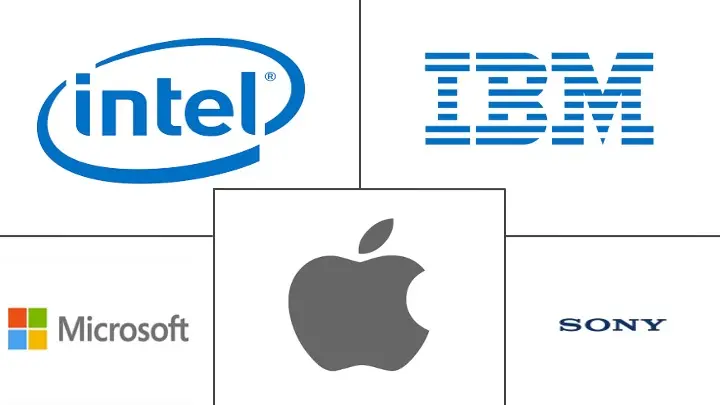Market Size of Consumer IoT Industry

| Study Period | 2019 - 2029 |
| Market Size (2024) | USD 139.51 Billion |
| Market Size (2029) | USD 206.60 Billion |
| CAGR (2024 - 2029) | 8.17 % |
| Fastest Growing Market | Asia Pacific |
| Largest Market | North America |
Major Players
*Disclaimer: Major Players sorted in no particular order |
Consumer Internet of Things (IoT) Market Analysis
The Consumer IoT Market size is estimated at USD 139.51 billion in 2024, and is expected to reach USD 206.60 billion by 2029, growing at a CAGR of 8.17% during the forecast period (2024-2029).
- Iot is the base of digital transformation worldwide, helping to transform many consumer, industrial, government, and defense applications. Even though IT spending fell in 2022, it is expected to grow in 2023. IoT will drive this IT expenditure with approximately 19% growth in 2023, as mentioned in a report by IoT Analytics. IoT deployment helps overcome labor shortages and could speed up digital transformation initiatives.
- Integrating 5G and IoT can promote many sustainability use cases in various industries. 83% of organizations have improved their efficiency by introducing IoT technology. For instance, with IoT applications in Water Industry, the utility company can recognize, monitor, manage, and monetize water distribution effectively in regions impacted by water scarcity. Smart Water solutions
- IoT is changing the healthcare industry with innovations like robot surgeons and smart hospitals, which take patient care to the next level. IoT devices that use sensor data help in health condition monitoring, early diagnosis, in-patient treatment, and more. For instance, Apple Smartwatch, which works on an IoT platform, is integrated with Fall Detection System and Emergency Call services that help save lives on time.
- The COVID-19 outbreak changed the perspective of consumers toward IoT. The introduction of IoT robots is catching demand in sectors like household, retail, manufacturing, healthcare, and others. For instance, Skilancer Solar, a clean-tech firm, developed a waterless robot for cleaning small-scale solar power plants on household rooftops. These robots will help to clean the panels as per requirement, without any human involvement.
- IoT may bring convenience and improve the productive time of daily tasks, but the implementation of it is pretty expensive, so there is slow adoption of this technology. The high cost involved in developing and maintaining these IoT devices restrains the market growth.
Consumer Internet of Things (IoT) Industry Segmentation
Any person leveraging IoT to improve daily lives other than enterprises is counted in the Consumer IoT Market. Connected devices designed for the consumer market, like smart wearables, smartphones, smart homes, etc., that collect and share data through an internet connection are the main components of this Consumer IoT Market. Consumer IoT applications are becoming more effective and user-friendly due to the quickly expanding computational capabilities.
The Consumer IoT Market is segmented by Type (Hardware, Solutions, Services), Application (Home Automation, Consumer Wearables, Consumer electronics, Healthcare, Automotive), and Geography.
The market sizes and forecasts are provided in terms of value (USD) for all the above segments.
| By Type | |
| Hardware (Components, such as Processors, Sensors, Gateways, Controllers, and Switches) | |
| Solutions (Independent Software and Integrated Platforms) | |
| Services (Device Lifecycle Management, Remote Monitoring, and implementation Services) |
| By Application | |
| Home Automation (Smart Thermostats, Meters, Locks, etc.) | |
| Consumer Wearables (Smart Watches, Glasses, Fitness Trackers, etc.) | |
| Consumer Electronics (Smart TV and Other Connected White Goods) | |
| Healthcare (Medical-grade Devices and Wearables, Platforms, etc.) | |
| Automotive (Infotainment System, Connected Cars, etc.) |
| Geography | |||||||
| |||||||
| |||||||
| |||||||
| |||||||
|
Consumer IoT Market Size Summary
The Consumer IoT market is poised for significant growth, driven by the increasing integration of IoT technologies across various sectors. As a cornerstone of digital transformation, IoT is reshaping consumer, industrial, and governmental applications, despite previous declines in IT spending. The market is expected to expand substantially over the forecast period, fueled by advancements in 5G technology and the growing adoption of smart devices. IoT's role in enhancing efficiency and promoting sustainability is evident in sectors like healthcare, where innovations such as robot surgeons and smart hospitals are revolutionizing patient care. The COVID-19 pandemic has further accelerated the adoption of IoT, with robots and smart solutions gaining traction in industries ranging from retail to clean-tech.
North America leads the charge in IoT adoption, with high 5G deployment rates and significant investments in smart city projects. The region's focus on technological innovation is evident in initiatives like smart parking systems and digital banking solutions for SMBs. The Consumer IoT market remains highly fragmented, with major players like Microsoft, Apple, and IBM investing in AI, machine learning, and big data to enhance their offerings. Collaborations and partnerships, such as those between Taoglas and Westbase.io, and Loriot and Disrupt-X, are driving the development of advanced IoT solutions across Europe and beyond. Despite the high costs associated with IoT implementation, the market's potential for growth and innovation continues to attract substantial investment and interest.
Consumer IoT Market Size - Table of Contents
-
1. MARKET DYNAMICS
-
1.1 Market Drivers
-
1.1.1 Increasing Adoption of Connected Devices and Technology Proliferation Among Consumers
-
1.1.2 Impact of 5G and Increased Cellular Networks
-
1.1.3 Increasing home automation is expected to flourish the market
-
-
1.2 Market Challenges
-
1.2.1 Government Regulations, Security and Privacy of Data and Interoperability Concerns
-
-
-
2. MARKET SEGMENTATION
-
2.1 By Type
-
2.1.1 Hardware (Components, such as Processors, Sensors, Gateways, Controllers, and Switches)
-
2.1.2 Solutions (Independent Software and Integrated Platforms)
-
2.1.3 Services (Device Lifecycle Management, Remote Monitoring, and implementation Services)
-
-
2.2 By Application
-
2.2.1 Home Automation (Smart Thermostats, Meters, Locks, etc.)
-
2.2.2 Consumer Wearables (Smart Watches, Glasses, Fitness Trackers, etc.)
-
2.2.3 Consumer Electronics (Smart TV and Other Connected White Goods)
-
2.2.4 Healthcare (Medical-grade Devices and Wearables, Platforms, etc.)
-
2.2.5 Automotive (Infotainment System, Connected Cars, etc.)
-
-
2.3 Geography
-
2.3.1 North America
-
2.3.1.1 United States
-
2.3.1.2 Canada
-
-
2.3.2 Europe
-
2.3.2.1 Germany
-
2.3.2.2 UK
-
2.3.2.3 France
-
2.3.2.4 Spain
-
2.3.2.5 Rest of Europe
-
-
2.3.3 Asia-Pacific
-
2.3.3.1 China
-
2.3.3.2 Japan
-
2.3.3.3 India
-
2.3.3.4 Australia
-
2.3.3.5 Rest of Aisa-Pacific
-
-
2.3.4 Latin America
-
2.3.4.1 Brazil
-
2.3.4.2 Mexico
-
2.3.4.3 Argentina
-
2.3.4.4 Rest of Latin America
-
-
2.3.5 Middle East and Africa
-
2.3.5.1 UAE
-
2.3.5.2 Saudi Arabia
-
2.3.5.3 South Africa
-
2.3.5.4 Rest of MEA
-
-
-
Consumer IoT Market Size FAQs
How big is the Consumer IoT Market?
The Consumer IoT Market size is expected to reach USD 139.51 billion in 2024 and grow at a CAGR of 8.17% to reach USD 206.60 billion by 2029.
What is the current Consumer IoT Market size?
In 2024, the Consumer IoT Market size is expected to reach USD 139.51 billion.

